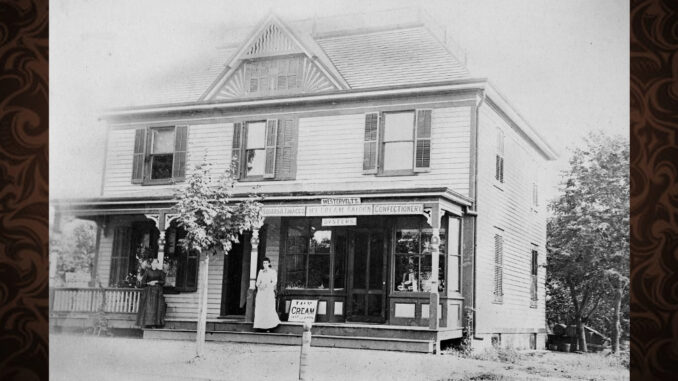
WESTWOOD—While the recent heat and humidity in the Pascack Valley has been pretty brutal, let’s all take a moment to be grateful for a couple of things: first, the fact that air conditioning has been invented, and second, that during the summer we don’t have to dress like the ladies shown in this photograph, above.
In the late 19th century, options for escaping the summer heat were rather limited. There was no such thing as holing up at home and blasting the air conditioner. Women wore long dresses and multiple layers (and corsets!) through all seasons, while men wore suits and hats all year long, with only the transition to lighter colors and breathable fabrics signaling the arrival of warm weather.
So, what could you do, other than just be miserable? Well, you could open the windows of your home to let in the breeze through cross-ventilation. You could also take a dip in one of the local lakes or brooks. You might have also sought out a cold treat at a place like Westervelt’s Ice Cream Saloon in Westwood, shown here.
This building is still standing today at the corner of Washington and Fourth avenues, but it is an apartment building and the Victorian architectural details have been replaced by a brick facade. The Westwood Borough Hall is next door.
Almost all ice cream parlors at the time served chocolate, vanilla, and strawberry; the classic Neapolitan was just as popular then as it is now. According to one news article from 1895, other popular ice creams at the time included fruit flavors such as apricot, banana, peach, pineapple, lemon, raspberry, orange, and cherry; and nutty flavors such as walnut, almond, hazelnut, and pistachio. Some places also had coffee-flavored ice cream and flavors made with various cookies, cakes, and puddings—a great way for a store to use up unsold desserts.
Westervelt’s also sold tobacco and cigars (their sign shows the older spelling segars), as was common for a confectionery shop at the time. It was also an oyster bar—which, from a modern perspective, probably seems like a very strange business model. Oysters and ice cream? As it turns out, the Westervelts were merely capitalizing on a food trend of their day. In the second half of the 19th century, advances in canning and refrigeration allowed oysters to be transported beyond the coastal cities that had always enjoyed them. Americans had a big appetite for the little mollusks. Just as every strip mall in northern New Jersey has its bagel shop and pizza parlor today, oyster saloons were everywhere in the late 19th century.
— Krisin Beuscher, a former editor of Pascack Press, is president of Pascack Historical Society in Park Ridge and edits its quarterly members’ newsletter, Relics.
